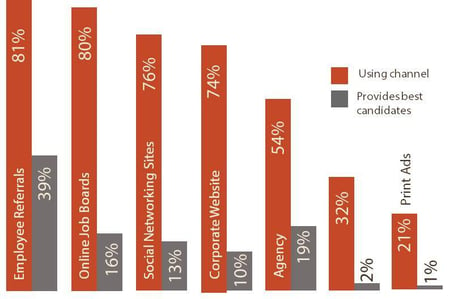Where are you looking for your candidates? And which channels are bringing you the highest quality recruits? We asked more than 450 HR professionals globally which channels they were using and which ones delivered the highest quality candidates.
Companies who participated in the 2015 McQuaig Global Talent Recruitment Survey are using, on average, four channels to source candidates as part of their recruitment strategies. The top four being: employee referrals, online job boards, social networking sites, and their corporate website.

Most companies are seeing good results from employee referrals and the majority of companies say they are using this channel. Other research I’ve seen suggests that 69% of companies have a formal employee referral program in place.
The top three recruiting channels in terms of delivering quality candidates are:
- Employee referrals
- Agencies
- Online Job Boards
When we look at just those companies who told us they’re having an easier time finding talent year-over-year, we call them Winners in our report, the results are a little different. Our Winners’ group are much heavier users of employee referrals (94%). They also rank social media as their 2nd most effective channel (twice as high as companies that are struggling) right behind employee referrals. Their top three channels for effectiveness are:
- Employee referrals
- Social networking sites
- Online Job Boards
Top Social Recruitment Strategies
Social recruiting is constantly growing in popularity and buzz. In our survey, 76% of respondents said they were using social media as one of their recruiting channels (81% of companies in our Winners group). Digging a little deeper, we asked those who are using social media to recruit, how they’re using it.

Use of LinkedIn, for either candidate search or job posting, topped the list for how companies are using social media. We found that usage was highest for LinkedIn in the US, where 84% were posting jobs there and 71% were searching for candidates; but in the UK and Europe those numbers fell to 54% and 42%. And use of social media in general was higher in the US and Canada.
Only ¼ (26%) are using employees as brand ambassadors and tapping into their social networks. This is one of the key reasons that so many companies just aren’t seeing results from social recruiting. To effectively engage passive candidates (and most high-potentials are passive) companies need to enlist their employees in carrying the employer brand message to their networks.
The Case for Advertising
I was surprised to see so few companies trying pay-per-click (PPC) advertising to reach candidates. Only 11% of our respondents are doing this right now. Arguably, this lies outside of social media; however, because many of the opportunities exist within social networks, I think it’s worth mentioning.
If you’re not sure what PPC is, it’s a type of online advertising where you only pay when someone clicks on your ad or piece of content. That could be a banner ad on someone else’s website, a paid ad on Google Adwords, a promoted Tweet on Twitter, or an ad or promoted post on LinkedIn or Facebook. Marketers have been using them for years and, as a result, these platforms have gotten very sophisticated in their ability to target a specific profile.
This is great for HR because you’re able to target your potential candidates – the ones who fit your employee persona – so precisely. For example, on LinkedIn, you can target an ad to be shown only to people in Illinois, working in a sales function in the manufacturing industry at the VP level. How cool is that?
Combine that level of targeting with a message that’s crafted directly to your target audience (using the employee persona or candidate profile you created) and you have a powerful tool to reach your ideal candidates.
This isn’t a stand-alone strategy, though. You still have to put in the effort to build your employer brand in these online channels and engage your passive candidates in the networks where they’re active, but if you have done that, these ads can be a very effective way to target them with an offer or relevant content.
Which channels do you get the best candidates from? Let us know in the comments.